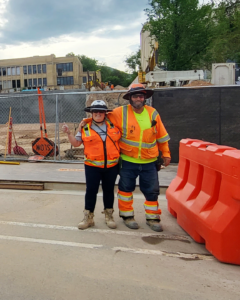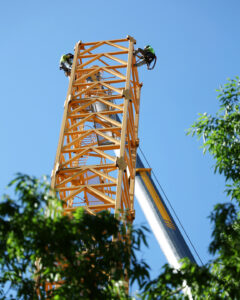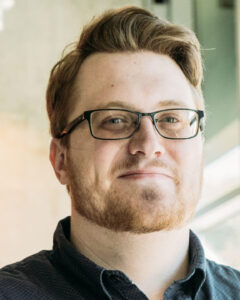Sandra J. Bromley Scholarship
Providing a Role Model for New Generations

Ray Greer. Banner Photo above: Dannon Allred, Ray Greer and his wife Jill, Michaela Fluck, Keegan Benfield, Eliza Roberts. Credit: Matt Crawley
The Sandra J. Bromley scholarship is a full-tuition scholarship for undergraduate students in the College of Science. It provides in-state tuition, up to 15 credit hours per semester, for eight semesters which allows each recipient to complete their degree. The program, now celebrating its 10-year anniversary, is funded by the generosity of Ray Greer, BS’86, in Mathematics.
Each year, a freshman student is selected as a new Bromley scholar, and rolls into the program, while a senior student graduates. This unique model provides continuous funding to the students and allows the College of Science to assist and monitor the students as they progress through their academic program.
“The Bromley scholarship is extremely valuable because it can serve a student throughout their entire undergraduate career,” says Peter Trapa, dean of the College of Science. “The cumulative effect for the student is truly profound. Each year we see the incredible results.”
In addition, Greer and his wife, Jill, host the Bromley scholars at least once a year on campus. The informal luncheon allows the students to report on their progress and discuss any problems or concerns.
“I have had the pleasure of meeting and getting acquainted with the undergraduates as they progress through their academic goals, and it is always a pleasure to see their progression and academic interest flourish over time. In all I have done throughout my life, this has been one of the greatest and most rewarding experiences I have had the opportunity to be a part of,” says Greer.
Role Model
When Greer was just 12 years old, his mother, Sandra J. Bromley, moved her young family from Texas to Utah. The year was 1976. Bromley was promptly hired at the University of Utah and enjoyed a successful career as a technical illustrator in the College of Mines and Earth Sciences under the direction of Frank H. Brown.
“My mother was the single greatest influence in my life,” says Greer. “She taught me the value of hard work and perseverance. She also insisted that college was not optional. It was like going from junior high to high school — you just did it!”
Greer enrolled at the U for fall semester 1981 and was initially interested in computer science and engineering. However, computer science was highly competitive at the time so available classes were scarce.
“Fortunately, Hugo Rossi, a math professor, convinced me that if I majored in mathematics I could get as much course work in computer science as I wanted,” says Greer.
For several years Greer worked through the rigorous mathematics major requirements. He persevered and completed his math degree in 1986.
Then, in 2000, Greer’s mother moved back to Texas for the remaining years of her life. She passed away in 2011. Shortly thereafter, Greer established the Sandra J. Bromley scholarship to honor his mother by providing a way for deserving students to earn a college degree.
“She worked hard to provide for her family, but her greatest regret in life was not attending college herself, hence the vision behind the Bromley scholarship,” says Greer.
“Her requirement was that she would support me as long as I didn’t quit school,” says Greer. “That is why the Bromley scholarship requires continuous attendance.”
Solving Problems
Greer has more than 40 years of experience in logistics and transportation industries. He has held senior management positions for Greatwide Logistics Services, Newgistics, Ryder Logistics and FedEx. He served as president of BNSF Logistics, headquartered near Dallas, Texas, from 2011 to 2018.
“Math allows me to think critically about situations and problems generally. Not just numerically but logically, to find patterns and trends that point to likely outcomes,” he says.
In 2018, Greer was named CEO of Omnitracs, a leading company in onboard technology for the transportation industry. Omnitracs is an international billion-dollar company that provides telematic devices and logistics to support drivers and their organizations to be compliant, safe and efficient.
“Math is universal and most importantly it teaches you discipline and persistence to work a problem until it is solved. That process of critical thinking and problem-solving has served me well throughout my entire career,” says Greer.
In 2021, Greer sold Omnitracs and transitioned to advisory board work as well as becoming an operating partner for Welsh, Carson, Anderson and Stowe, focused on supply chain technology investments.
Ray Greer has high hopes and expectations for today’s college students. His advice: “Connecting with people — not apps and cell phones — will differentiate you from the competition.”
The Bromley Scholars
Eliza Robert
“I love the entire vibe of the university”
 Eliza Roberts is the most recent recipient of the Bromley scholarship. A freshman at the U, she is pursuing a degree in applied math and physics, with an emphasis in astronomy and astrophysics. Being awarded this scholarship has made Roberts’ experience at the U even more valuable. “It has truly allowed me to focus more on my classes, and even take classes that I wouldn’t have taken otherwise,” she says. “With the scholarship, I don’t have to worry about the financial aspects of college like I was fully intending to, which means that I can explore my passions and dedicate my time to learning.”
Eliza Roberts is the most recent recipient of the Bromley scholarship. A freshman at the U, she is pursuing a degree in applied math and physics, with an emphasis in astronomy and astrophysics. Being awarded this scholarship has made Roberts’ experience at the U even more valuable. “It has truly allowed me to focus more on my classes, and even take classes that I wouldn’t have taken otherwise,” she says. “With the scholarship, I don’t have to worry about the financial aspects of college like I was fully intending to, which means that I can explore my passions and dedicate my time to learning.”
In addition to her hard work as a student, Roberts works as a math tutor in the TRIO office at the U. One of her proudest accomplishments is receiving her Girl Scout Gold award, for which she focused on creating a safe backyard space for adults with disabilities.
Roberts lives in Salt Lake City and makes the most of her time at the U participating in LEAP classes, a year-long learning community for entering University students, and even discovering top-secret study and nap spots on campus. “I love the entire vibe of the university,” she says. “I feel safe, valued, and free. I have been able to explore myself more than I have in years, and it has helped me figure out who I want to be.”
~Julia St. Andre
Dannon Allred
“Space is simply beautiful”
 Dannon Allred was awarded the Bromley Scholarship in 2021 and just completed his sophomore year at the U. A passionate learner, he is studying physics with an astronomy emphasis. “Ever since I’ve been interested in science, I’ve felt a pull towards physics and astronomy,” he says. “There’s just a lot in astronomy that spikes my curiosity, there’s a lot that’s unknown, and [outer] space is simply beautiful.”
Dannon Allred was awarded the Bromley Scholarship in 2021 and just completed his sophomore year at the U. A passionate learner, he is studying physics with an astronomy emphasis. “Ever since I’ve been interested in science, I’ve felt a pull towards physics and astronomy,” he says. “There’s just a lot in astronomy that spikes my curiosity, there’s a lot that’s unknown, and [outer] space is simply beautiful.”
The Bromley scholarship has given Allred the opportunity to experience college without any financial worries and has allowed him to focus more of his energy on his passion for astrophysics. “Obviously one of the most daunting things about college is paying for it, and that’s a lot of stress that most students have to deal with,” he says. “I would say that’s what’s most impactful about the Bromely scholarship because it allows me to go through college stress-free in that aspect.”
On top of his astrophysics studies, Allred has been involved in several research projects on campus. “In my freshman year, I was part of Dr. Boehme’s … lab as part of the Science Research Initiative doing research on Organic Light-Emitting Diodes (OLEDs) using spintronics,” explains Allred. “This spring, I did an introductory research project analyzing the spectral emission features of the Sombrero Galaxy with Dr. Anil Seth” who specializes in astrophysics.
Allred’s hope is to complete a graduate degree in the field as well. Not surprisingly, when he’s not busy studying stars and galaxies far, far away, he loves astrophotography, admiring the universe through the lens of his camera. ~ Julia St. Andre
Michaela Fluck
“Proceeding Into the Wilderness”
 Michaela Fluck works in the Zelikowsky Lab, which researches neural circuits that affect stress, fear, and social behavior. “I’ve always been interested in neurobiology, since I was a kid,” she states. “I’ve had family members who’ve had strokes and other brain injuries.”
Michaela Fluck works in the Zelikowsky Lab, which researches neural circuits that affect stress, fear, and social behavior. “I’ve always been interested in neurobiology, since I was a kid,” she states. “I’ve had family members who’ve had strokes and other brain injuries.”
A biology major with a psychology minor, Fluck says the study of abnormal psychology is also a passion of hers. “Seeing what can go wrong with the brain and what’s behind [it] … is super interesting as well.”
Fluck was inspired to become a doctor by her patients at Primary Children’s Hospital, where she works as a phlebotomist. “I want to become an advocate for patients,” she says, “and help people work through the difficulties of medicine. Kids tend to hate procedures no matter what, so helping them work through the procedures is honestly one of the most rewarding things I’ve ever done.”
Her favorite class was organic chemistry. “Not a lot of pre-meds can say that,” she jokes. Fluck also loved taking an acting class at the U which relieved the stress of being a STEM student and harked back to her time as an actress in high school, especially her appearance in the the late Stephen Sondheim’s epic musical saga about daring to venture Into the Woods. ~ CJ Siebeneck
Keegan Benfield
“Who knew I could do that?”
 As a Bromley Scholar, Keegan Benfield BS’23, was able to spend more time on scientific passions, such as research and projects. “The Bromley Scholarship and the U have helped shape me to be the best that I can be.”
As a Bromley Scholar, Keegan Benfield BS’23, was able to spend more time on scientific passions, such as research and projects. “The Bromley Scholarship and the U have helped shape me to be the best that I can be.”
Along with his double majors in mechanical engineering and physics, Benfield focuses his time on humanitarian efforts, volunteering with Youthlinc and Real life programs. He’s the president of the university’s marksmen club, and has attended National Collegiate events at the National and Junior level.
Prior to graduation, Benfield worked in the Deemyad Lab, researching condensed matter physics. The Lab focuses on theoretical physics, especially the physics of matter at extreme conditions of temperature and pressure.
One of Benfield’s favorite classes was Introduction to Relativity and Quantum Mechanics. “It was an ‘ah-ha!’ class that was challenging and fun,” Benfield says. “I have learned and expanded my knowledge in ways that amaze me. Who knew I could do that?”
Benfield recently completed a summer internship at Cosm and developed educational programs for planetariums using Digistar 7, which features full-dome programs and production services, giant screen films formatted for full-dome theaters, premium-quality projection domes, and theater design services. He plans on getting a master’s or PhD and work in a national laboratory or research company. ~ CJ Seibeneck
 Bowen is a Professor of Geology and Geophysics and Director of the
Bowen is a Professor of Geology and Geophysics and Director of the 



 Dr. Ofer Rog’s research focuses on the complex regulation of chromosomes during meiosis. Dr. Rog and his assembled team of top-notch researchers have developed new methods, used innovative approaches, and carried out meticulous studies that are now revealing key elements of this complex process. The work conducted by him and his research group has provided stunning insights into the fundamental cellular processes explaining the origin and maintenance of different sexes, including our own. As Director Frederick Adler states, “Dr. Rog is also an extraordinary communicator with a dedication to helping colleagues and students find new ways to communicate.”
Dr. Ofer Rog’s research focuses on the complex regulation of chromosomes during meiosis. Dr. Rog and his assembled team of top-notch researchers have developed new methods, used innovative approaches, and carried out meticulous studies that are now revealing key elements of this complex process. The work conducted by him and his research group has provided stunning insights into the fundamental cellular processes explaining the origin and maintenance of different sexes, including our own. As Director Frederick Adler states, “Dr. Rog is also an extraordinary communicator with a dedication to helping colleagues and students find new ways to communicate.”
 Nicholas Witham is the first-place winner of the
Nicholas Witham is the first-place winner of the  minimal maintenance. Due to their self-contained nature, the impact and effect of these units on the surrounding environment is very minimal. “It’s essentially a big black box that we plan to put in the middle of the desert. I contacted the local EPA office about this to see if there was anything I was missing, and they had no real concerns. Because we’re putting it in a box, any microplastics that might be generated by the textiles shearing or breaking catastrophically would be contained,” he states.
minimal maintenance. Due to their self-contained nature, the impact and effect of these units on the surrounding environment is very minimal. “It’s essentially a big black box that we plan to put in the middle of the desert. I contacted the local EPA office about this to see if there was anything I was missing, and they had no real concerns. Because we’re putting it in a box, any microplastics that might be generated by the textiles shearing or breaking catastrophically would be contained,” he states.
 Jon Wang is an Earth systems scientist and recently joined the faculty of the School of Biological Sciences as an assistant professor.
Jon Wang is an Earth systems scientist and recently joined the faculty of the School of Biological Sciences as an assistant professor. 